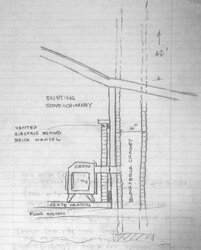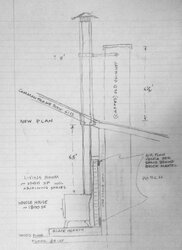BeGreen raised a question about the Jotul Oslo size vs our proposed 13 ft Metal-fab chimney in my first post.
I didn't think of the relationship between stove size, chimney height, and climate (mild by comparison). So let me add more info - and raise more questions.
We are planning to get a new woodstove and chimney system (hopefully this winter if we can figure this out.)
We burn fires when temps are mid-40s and below. (Gets down to teens some nights.)
Our hearth is in a room about 320 SF with ceiling at 6:12 pitch, at 8' to 13' high... but there are two adjoining rooms with no doors, one being an upstairs room. Total SF of all three spaces, plus a bit for the top of the LR, I figure to be about 1000 SF. The whole house is 1800SF.
Here are some sketches I just did this morning to give a better idea of our set up.... both the existing stove set up and our plan.
Our local woodstove dealer (and only known local installer) sells Jotul, Lopi, and morso... though they have no wood burning stoves in their showroom. My wife and I made a trip to Gainesville recently to look at these stoves (as well as VCs, and Windsor steel stoves). We liked the Jotul best. We also researched PE Alderleas, but there are no dealers anywhere close to us.
Our old Sierra (steel) has been a real workhorse and has required little maintenance and no repair for the past 25 years. It is oversized and can heat us out of the room. But it is tough to start, and we have had to deal with too much smoke in the house. We use split oak from our own woods, seasoned at least a year. We want a stove (and chimney system) that won't smoke when we open the door to reload, and burns cleaner. (The Jotuls offer the enticing option of a screen for open fire viewing - does that really work?)
Our old stove is a side loader. The Oslo also has a side door which is appealing for reloading a hot firebox. The next size down - Castine - does not have the side door.
So, what size stove? Should we make the chimney taller? By how much? Is the Oslo too big for our house? Is Jotul a good choice for us?
All feedback will be much appreciated.
I didn't think of the relationship between stove size, chimney height, and climate (mild by comparison). So let me add more info - and raise more questions.
We are planning to get a new woodstove and chimney system (hopefully this winter if we can figure this out.)
We burn fires when temps are mid-40s and below. (Gets down to teens some nights.)
Our hearth is in a room about 320 SF with ceiling at 6:12 pitch, at 8' to 13' high... but there are two adjoining rooms with no doors, one being an upstairs room. Total SF of all three spaces, plus a bit for the top of the LR, I figure to be about 1000 SF. The whole house is 1800SF.
Here are some sketches I just did this morning to give a better idea of our set up.... both the existing stove set up and our plan.
Our local woodstove dealer (and only known local installer) sells Jotul, Lopi, and morso... though they have no wood burning stoves in their showroom. My wife and I made a trip to Gainesville recently to look at these stoves (as well as VCs, and Windsor steel stoves). We liked the Jotul best. We also researched PE Alderleas, but there are no dealers anywhere close to us.
Our old Sierra (steel) has been a real workhorse and has required little maintenance and no repair for the past 25 years. It is oversized and can heat us out of the room. But it is tough to start, and we have had to deal with too much smoke in the house. We use split oak from our own woods, seasoned at least a year. We want a stove (and chimney system) that won't smoke when we open the door to reload, and burns cleaner. (The Jotuls offer the enticing option of a screen for open fire viewing - does that really work?)
Our old stove is a side loader. The Oslo also has a side door which is appealing for reloading a hot firebox. The next size down - Castine - does not have the side door.
So, what size stove? Should we make the chimney taller? By how much? Is the Oslo too big for our house? Is Jotul a good choice for us?
All feedback will be much appreciated.




